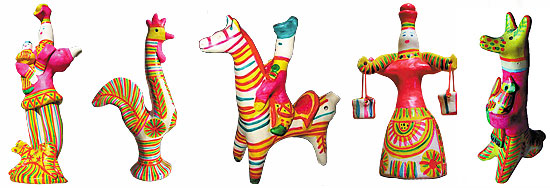FILIMONOV TOY
Filimonov toy is a Russian craft which got its name from the famous toy manufacturing center - the village Filimonovo (Odoyev district of Tula province).
The craft originated in the middle of 19th century at the potters community. Thanks to the excellent quality of the local white clay they made pottery in that area since 16th century. The ready pots were passed to trade-dealers for distribution or sold independently at local markets. As in most potters communities, the whole family worked – men made various kinds of pots and clay dishes while women modeled and painted toys.
According to the experts’ opinion, Filimonov toys still preserve the original, ancient traditions of the Russian folk culture. The toys are quite striking in appearance as they have a very original and unusual form. Of course its appearance was greatly influenced by the natural qualities of the local white clay with a bluish tint – the so-called "blueing". During the drying process the soft, pliant and overly rich clay can be easily deformed and gets covered with tiny cracks that have to be wiped out with a wet hand. This is why figurines thin out, getting a disproportionate but surprisingly elegant slender shape. After firing the clay acquires a smooth white color, which does not require any subsequent priming.
All Filimonov toys have elongated proportions and soft contours. The toys vary in size from 3-5 to 25-30 cm. The majority of them are traditional whistles shaped as ladies, horsemen, cows, bears, roosters, etc. Images of people are monolithic, spare in details and close to primitive ancient sculptures. The narrow bell skirt of a Filimonov lady turns smoothly into a short narrow body that ends with a conical head almost as wide as the neck. In her rounded arms the lady usually holds a baby or a bird-whistle.
Gentlemen look exactly like the ladies, but instead of skirts they have thick cylindrical legs, shod in clumsy boots. The heads of the figures are crowned with fanciful hats with narrow brims. Of interest are compositions of several figures.
The animals all have a thin waist and a long, gracefully curved neck which ends with a small head. Only the shape of the muzzle and the presence or absence of horns and ears can help the looker to distinguish one animal from another.
Filimonov craftsmen painted their toys with bright aniline paints mixed with egg yolks. Today, as well as in the old days they draw ornaments with a chicken feather. Despite a relatively poor palette, dominated by only three-four colors – crimson-red, emerald green, yellow and blue – the toys look bright and cheerful.
The painting pattern consists of horizontal stripes of various colors against the white or yellow background. The ornaments are mostly circles, rosettes, triangles, zigzags and dots. Faces and small details are barely marked as in the ancient pagan idols. Animals are traditionally painted with colorful stripes along the body and neck. The head and the chest area are painted with one color, usually green or crimson, often embellished with a simple and rather clumsy ornament.
Filimonov ladies and gentlemen are dressed elegantly and brightly, their hats are decorated with colorful stripes, the collars, skirts and pants are covered with the same simple pattern. The outwear style was clearly formed under the influence of urban culture with addition of elements of peasant culture – homespun dresses, embroidered shirts and belts. Randomly applied ornamentations (multicolored strokes, spots, sprigs, lines) create a bright and colorful decorative effect.
Manufacturing of Filimonov toys diminished sharply in the early 20th century, though several artists continued to work, trying to preserve the old traditions. In the 60-s of 20th century thanks to the efforts of art historians and collectors this craft was brought back to life, and is now observing traditional methods of sculpting and painting.

